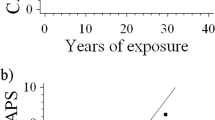Abstract
Objective
The aim of this study was to explore the association between exposure to specific pesticides (including endocrine disrupters) of greenhouse workers and spontaneous abortion in their spouses.
Methods
A group of exposed workers was compared with a non-exposed group. The risk of spontaneous abortion was evaluated using a logistic regression model.
Results
A significantly higher rate of spontaneous abortion was observed among spouses of workers exposed to specific compounds (atrazine, benomyl-carbendazim, carbaryl and DDT) in comparison with spouses of the unexposed group. The logistic regression model confirmed the increased risk of spontaneous abortion (OR=11.8; 95% CI 2.3–59.6).
Conclusions
These findings suggest that occupational exposure to pesticides might have an adverse effect on the partner’s reproductive health.
Similar content being viewed by others
References
Petrelli G, Mantovani A. Environmental risk factors and male fertility and reproduction. Contraception 2002; 65: 297–300.
Pant N, Srivastava SC, Prasad AK, Shankar R, Srivastava SP. Effects of carbaryl on the rat’s male reproductive system. Vet Hum Toxicol 1995; 37: 421–425.
Traina ME, Rescia M, Urbani E, Mantovani A, Macri C, Ricciardi C, Stazi AV, Fazzi P, Cordelli E, Eleuteri P, Leter G. Spano M. Long-lasting effects of lindane on mouse spermatogenesis induced by in utero exposure. Reprod. Toxicol. 2003; 17: 25–35.
World Health Organization. Carbendazim. Environmental Health Criteria, 149. Geneva: WHO, 1993.
Mantovani A. Hazard identification and risk assessment of endocrine disrupting chemicals with regard to developmental effects. Toxicology 2002; 181–182: 367–370.
Mantovani A, Stazi AV, Maranghi F, Macri, C, Ricciardi C, Problems in testing and risk assessment of endocrine disrupting chemicals with regard to developmental toxicology. Chemosphere 1999; 39: 1293–1300.
Turusov V, Rakitsky V, Tomatis L. Dichlorodiphenyltrichloroethane (DDT): ubiquity, persistence, and risks. Environ. Health Perspect. 2002; 110: 125–128.
Joffe M. Are problems with male reproductive health caused by endocrine disruption? Occup. Environ. Med. 2001; 58(4): 281–287.
Whorton MD, Krauss RM, Marshall S, Milby TH. Infertility in male pesticide workers. Lancet 1977; 2: 1259–1261.
DeCock J, Westveer K, Heederik D, De Velde E, van Kooij R. Time to pregnancy and occupational expsoure to pesticides in fruit growers in The Netherlands. Occup. Environ. Med. 1994; 51(10): 693–699.
Petrelli G, Figà-Talamanca I. Reduction in fertility in male greenhouse workers exposed to pesticides. Eur. J. Epidemiol. 2001; 17: 675–677.
Arbuckle TE, Lin Z, Mery LS. An exploratory analysis of the effect of pesticide exposure on the risk of spontaneous abortion in an Ontario farm population. Environ. Health Perspect. 2001; 109(8): 851–857.
Hoyer PB. Reproductive toxicology: current and future directions. Biochem. Pharmacol. 2001; 62(12): 1557–1564.
Hales BF, Robaire B. Paternal exposure to drugs and environmental chemicals: effects on progeny outcome. J. Androl. 2001; 22(6): 927–936.
Stoker TE, Laws SC, Guidici DL, Cooper RL. The effect of atrazine on puberty in male wistar rats: an evaluation in the protocol for the assessment of pubertal development and thyroid function. Toxicol. Sci. 2000; 58(1): 50–59.
Korrick SA, Chen C, Damokosh AI, Ni J, Liu X, Cho SI, Altshul L, Ryan L, Xu X. Association of DDT with spontaneous abortion: a case-control study. An. Epidemiol. 2001; 11(7): 491–496.
Hess RA. Effects of environmental toxicants on the efferent ducts, epididymis and fertility. J. Reprod. Fertil. Suppl 1998; 53: 247–259.
Gandley R, Anderson L, Silbergeld EK. Lead: male-mediated effects on reproduction and development in the rat. Environ. Res. 1999; 80(4): 355–363.
Anderson D, Dobrzynska MM, Basaran N. Effect of various genotoxins and reproductive toxins in human lymphocytes and sperm in the Comet assay. Teratog. Carcinog. Mutagen. 1997; 17(1): 29–43.
Rupa DS, Reddy PP, Reddi OS. Reproductive performance in population exposed to pesticides in cotton fields in India. Environ. Res. 1991; 55(2): 123–128.
Parròn T, Hernandez AF, Pla A, Villanueva E. Clinical and biochemical changes in greenhouse sprayers chronically exposed to pesticides. Hum. Exp. Toxicol. 1996; 15: 957–963.
Savitz D, Arbukle T, Kaczor D, Curtis KM. Male pesticide exposure and pregnancy outcome. Am. J. Epidemiol. 1997; 146: 1025–1036.
Arbuckle TE, Savitz DA, Mery LS, Curtis KM. Exposure to phenoxy Herbicides and the risk of spontaneous abortion. Epidemiology 1999; 10: 752–760.
Osborn JF, Cattaruzza MS, Spinelli A. Risk of spontaneous abortion in Italy, 1978–1995, and the effect of maternal age, gravidity, marital status, and education. Am. J. Epidemiol. 2000; 151: 98–105.
Author information
Authors and Affiliations
Corresponding author
Rights and permissions
About this article
Cite this article
Petrelli, G., Figà-Talamanca, I., Lauria, L. et al. Spontaneous abortion in spouses of greenhouse workers exposed to pesticides. Environ Health Prev Med 8, 77–81 (2003). https://doi.org/10.1007/BF02897919
Received:
Accepted:
Issue Date:
DOI: https://doi.org/10.1007/BF02897919




